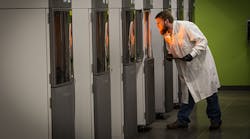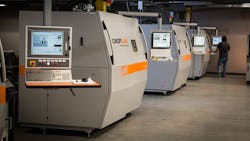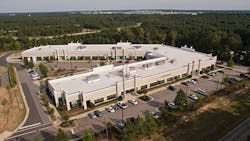Few companies across the country grabbed the headline potential of Manufacturing Day quite like Proto Labs.
On Wednesday, the 17-year-old, Minnesota-headquartered on-demand manufacturer of custom prototypes and production parts, released the results of a new survey that dives into how the public perceives manufacturing right now. Today, the company opened the doors to a new 3-D printing facility in Cary, North Carolina, in the heart of the Research Triangle, that, at 77,000 square feet, almost triples its physical manufacturing footprint.
Proto Labs CEO Vicki Holt recently discussed some of the findings of the survey — 71% of the 1,023 adult respondents said they do not perceive manufacturing jobs as high-tech, 55% still associated manufacturing with manual labor, 33% didn’t think of manufacturing jobs as high-paying, and just 10% associated manufacturing jobs with software development — as well as how America can become a digital manufacturing leader.
IW: This survey seems particularly timely, and not even because of Manufacturing Day. It really reflects the constant struggle in getting the general public to better understand manufacturing.
VH: Part of the reason I think getting data like this is important is I am really excited about manufacturing in North America and the opportunity that we have to lead in digital manufacturing. If you think about it, the United States is the leader in information technology and software, and you couple that with the manufacturing capabilities we have — and manufacturers are now stepping up and saying, ‘I can use information to digitize my process and connect my plant’ — and we have a chance to lead Manufacturing 4.0.
What are some of the obstacles? One of those is the workforce. We have to make sure we can attract the talent that will propel the growth we want to see in the digital age. We have to be a great place to work — and as you see in the survey, 71% don’t really perceive manufacturing jobs as high-tech jobs. Our manufacturing on both the plant floor and the software developers and engineers that will lead us into that digital work are very high-tech jobs. Only 10% of the respondents associated software development to manufacturing.
That’s why this survey is important. We have to start changing perception, in high school, with parents, so everybody knows this is a great place to work.
IW: Even with the 3% margin of error, the number of respondents who don’t perceive manufacturing as high-tech is still at least 68%. Did you get any feel from the respondents as to why that number is so high? Is perception stuck in images of the Rust Belt and 1980s movies like Flashdance and The Deer Hunter?
VH: I’m sure that’s what it is. They associate it with that, or they see photos of plants where a lot of people are doing manual assembly in a dirty environment that’s dark and old. There aren’t enough photos of Manufacturing 4.0 plant floors. … We have to be changing the perception of manufacturing. It’s not just blue-collar, although there are a lot of blue-collar jobs, even in the digital world. … We need talent across all those different spectrums.
IW: There were a few more numbers that jumped out, including that about one-third of respondents saying they don’t think manufacturing is high-paying. I imagine that goes hand in hand with not thinking the industry is high-tech. Again, is it just a matter of getting information out, of educating people?
VH: It is, exactly, and that’s educating the kids and the parents. We work hard here in the Minneapolis area to educate high school kids about manufacturing jobs, and we work closely with tech schools. I tell these kids, they can go to a two-year tech school, get a degree, come work with us for a couple of years and they can earn $80,000 a year. These are good jobs. You go to a four-year school, get a liberal arts education and you’re working at Starbucks — if you can find a job. … We know we have to compete for software engineers with technology companies like Amazon and Facebook and all those guys, and we know we have to pay, and we do. We know what the market rates are and we compete for those people.
IW: What else from the survey really popped out at you or surprised you?
VH: None of it surprised me, being involved locally and nationally talking about digital manufacturing, where we need to go, and listening to the responses that come from that. That’s part of the reason we wanted to do this survey: we need to elevate the conversation so that we can be having it in a more informed way. None of it surprised me, we just have a lot of work and a lot of opportunity ahead of us. To be leading in manufacturing again, here in America, it’s going to move away from places like China back to North America … it can be the basis for our economic growth.
IW: The other big news from Proto Labs is the new plant in Cary, North Carolina.
VH: I think it’s very appropriate that we’re celebrating Manufacturing Day in a facility that has a state-of-the-art 3-D printing platform. It’s a big expansion, going to 77,000 square feet from about 26,000 square feet across several locations. We’ll employ 150 people there, but our plan is to add another 170 jobs as we continue to grow. The 3-D printing business is growing about 30% to 40% a year.
IW: Why North Carolina? What was it about the state that really attracted this interest for the expansion and the new facility?
VH: It was actually a really pretty easy decision. We got into 3-D printing with the acquisition of FineLine in May 2014, and with that acquisition we brought with us a really talented workforce that we’ve continued to build on organically. The foremost reason is just that we have a fantastic workforce, and I don’t want to lose any of them. The other thing is that North Carolina really has some nice talent. There are a couple universities there — N.C. State has a whole 3-D printing program there — and a whole lot of intellectual power in the Raleigh-Durham Triangle. Also, frankly, North Carolina is a very friendly state to do business in.
IW: What is the ultimate goal with tripling your footprint?
VH: We’re growing across all of our processes — stereolithography, selective laser sintering, and direct metal laser sintering — and we’ll have a 3-D printing Protoworks location in Raleigh, as well, and housing the new HP 3-D Jet Fusion printer there. (Protoworks is the company’s center for researching, developing and market-testing new and accelerated manufacturing processes for prototype or low-volume production.) … The other thing that’s happening in 3-D printing, particularly in the metal base is the pull into production. We do some production parting today, in the aerospace area and the medical area, but we’ll be working more publicly with a set of beta customers, to refine what that looks like, what kind of investment that will need, and what that model looks like to work with customers to production.
This is going to sound really corny, but we can make a difference in two ways: We can be a leader for digital manufacturing for the world, and we can really make a difference in manufacturers’ ability to innovate and drive their own revenue growth by helping them take advantage of this digital model.





